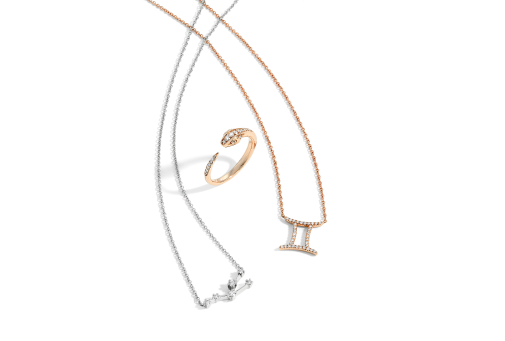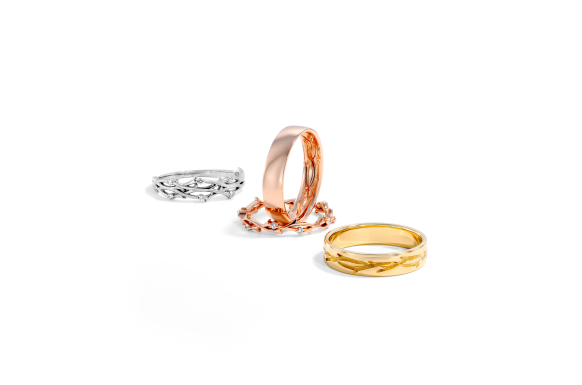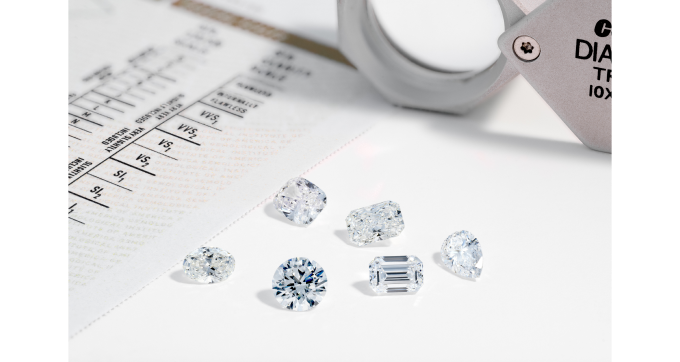Lab diamonds are seriously magical. They've got all the sparkle, shine, and luxuriously divine appeal of a natural diamond at half the price. But what's so special about these science rocks, and why do they totally rebury the competition? The beauty is in the similarity. The major W is in all the little differences that make the world a slightly better place. No, for real tho. Let’s get into it.
Seriously Squished Carbon
Like all diamonds, lab diamonds are made out of incredibly compressed carbon. This is done in a few different super-sciency ways that we get into here: in our education blog. For today, we’ll spare you the deets. Diamonds are the hardest substance on Earth, meaning they can only be scratched by another diamond. This makes them awesome for all sorts of things, our fav, of course, being sparkly fingers.
Lab-produced diamonds come with all sorts of benefits, like saving money, saving the earth, and saving lives. It sounds a bit dramatic, but is it? Not really. Lab diamonds are all yes with none of the yikes of a natural diamond. You can also get one twice the size for half the price, and that’s a W, any way you slice it.
Scientifically Snatched
So, how do you pick the perfect lab diamond? The same way you choose any other diamond. Start with a budget, use the 4Cs to finesse your way into the perfect engagement ring, and go home happy. Easy Peasy.
You Do You
Deciding on your budget has a few factors you may not have considered. So before you get out your adding machine, here’s some food for thought. The two-month salary rule is outdated. Many couples are choosing to save on the ring and spend on building their life together instead.
Fortunately, when it comes to lab diamonds, you don’t have to choose. That’s because lab-made diamonds are way more affordable than natural ones. So you can save up to a comfortable number and still get a killer engagement ring. Rather dive right in? You can always look into a payment plan instead. Engagement rings are a big purchase. It’s also something you’ll have forever, so don’t hesitate to drop a little cash to ensure you’re getting a quality piece. Once you decide on a budget, you can start in on the sparkle.
Slice Is Supreme
The cut is the most important factor in choosing any diamond. A good cut is responsible for everything we love about diamonds, from brilliant sparkle to colorful pops of fire.
For lab diamonds, always try to snag an excellent-ideal cut.
The good news is you can tell if a lab diamond has a good cut by seeing how it sparkles in the light. Look for a stone that reflects tons of light, and avoid any rocks with visible dark spots or facets.
A poorly cut diamond will absorb light, look a bit sad, and have lots of these dark facets. A well-cut diamond will sparkle for days.
Now You C It
Diamond clarity refers to the number of visual blemishes and inclusions in a stone. You always want to find an eye-clean diamond. But that doesn’t mean you need to splurge on a flawless rock.
Brilliant-cut lab diamonds have loads of sparkle, and all that glittery goodness can hide a lot of imperfections.
Step-cut stones like Emeralds, on the other hand, act more like windows, showing off every blemish. Still, all you need is eye-clean.
Look for a lab-grown diamond in the VS range. These diamonds are always eye-clean, saving you money over a higher clarity grade every time.
Colors Of The Wind
If you’re shopping for white diamonds, you want to find one that’s the color of the wind, AKA colorless. Or at least one that appears colorless. Round brilliant diamonds can hide a bit more color than other cuts due to their intense sparkle. But no matter the diamond cut, you can save a little money on color.
Look for a lab diamond in the G-H range. They’ll appear colorless and save you a grip over D-F color diamonds. If you’re setting your stone in rose or yellow gold, sometimes you can get away with a little more color, like an I grade.
Big Rocks
Finessing a lab diamond's color and clarity grades a bit can save you big money on your engagement ring. Now you can spend the rest of your budget making sure it’s a big ring by dropping those extra dollars on carat. However, we know carat isn’t everything. Finger coverage can make a diamond look bigger too!
Elongated stones cover more of the finger, making them look larger, which can save a little skrilla too. So now you can get a diamond of the same carat weight that looks a bit bigger. It’s like we’re giving away free money here.
Same/Same
Lab-grown diamonds are identical to natural ones. The only difference is their origin and price tag.
The stones themselves are the same down to the atomic level. Even with specialized equipment, it’s hard to tell them apart. Really there are not two different diamonds. There are two types of diamonds. So, which one is better? That depends on how much you want to spend on the same diamond.
Big Dif
So, what’s the big difference between these two types of diamonds? We can break that down into a couple of categories. Inside and out, the two diamonds look identical. But the way they’re created is vastly different, as is their price.
• Natural diamonds are created deep under the earth's crust, where they are formed by pressure over millions of years. Later they’re mined, pulled out of the ground, and processed.
• Lab diamonds are created in, you guessed it, labs. They’re formed with the same carbon under artificial pressure in a much shorter time frame. Then the stones are sorted under conditions that are a bit more friendly.
Tree Hugger or People Lover?
Can’t we be both? Ok, this is going to sound like it should have some Sarah McLachlan playing in the background, but we’re super cereal.
Lab diamonds are a much more eco-friendly option. Their artificial processing creates a smaller carbon footprint that continues to improve with advancing technology. Natural diamond mining causes irreparable damage to the earth.
The ethical concerns behind diamond mining have been running deep for decades. Stones change hands so much that it’s hard to tell where one came from and who dug it up. Avoiding stones mined in poor conditions and by child labor can be hard.
Lab Diamonds are always ethical. They’re made in a climate-controlled lab under comfortable conditions, complete with coffee breaks.
At Keyzar, we go to every length to ensure the natural diamonds we sell are conflict-free. Fortunately, we’re not the only diamond company that does so. Many companies are doing a great job of working toward the ethical mining of natural diamonds.
When it comes to natural diamonds, the process is incredibly hard to track, making it hard to tell if they were ethically mined. With lab diamonds, there is never a question. It’s just that easy.
Dolla Dolla Bills Y’all
On average, lab diamonds cost about half the price of natural ones. This is partially due to the artificially inflated supply and demand created by big-time diamond companies. Thanks, boomers.
Lab diamonds are produced according to demand, meaning the price is the fair market value. It’s never overinflated due to some diamond cartel, a huge corporation, or your mom. With lab diamonds, you’re paying a more fair price. That means you can get a bigger and better stone for the same price and pay off your student loans–hey, we can dream, right?
Ready To Seize That Scientific Sparkle?
Ready to snag the giant rock of your dreams? Lab diamonds are sparkly, stunning, and half the price of their natural twins. Not to mention they’re a whole lot more earth-friendly.
Finding the right lab diamond engagement ring is all about finesse. With a little 4Cs know-how in your pocket, you’ll be able to snatch a bigger, brighter, and all-around better stone while saving some serious skrilla. What’s not to love?






